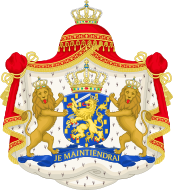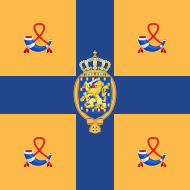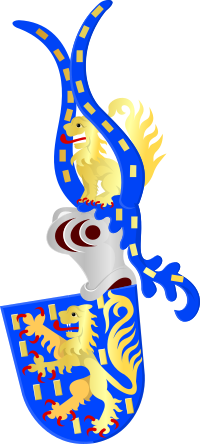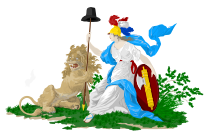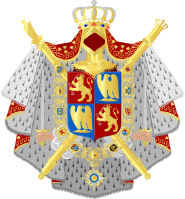Coat of arms of the Netherlands facts for kids
Quick facts for kids Coat of arms of theKingdom of the Netherlands |
|
|---|---|
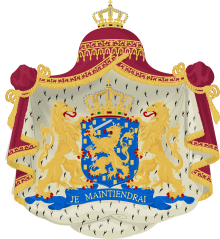
Greater (royal) version
|
|
| Versions | |
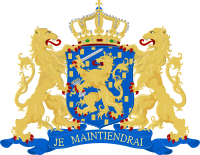
Middle (state) version
|
|
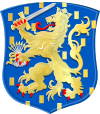
Lesser version
|
|
| Armiger | Willem-Alexander of the Netherlands |
| Adopted | 10 July 1907 23 April 1980 |
| Crest | Dutch royal Crown |
| Blazon | Azure, billetty Or a lion with a coronet Or armed and langued Gules holding in his dexter paw a sword Argent hilted Or and in the sinister paw seven arrows Argent pointed and bound together Or |
| Supporters | Two lions rampant Or armed and langued Gules |
| Motto | French: Je Maintiendrai |
| Other elements | The monarch places this coat of arms on a mantle gules lined with Ermine. Above the mantle is a pavilion gules again topped with the royal crown. |
| Earlier version(s) | 24 August 1815 |
The coat of arms of the Kingdom of the Netherlands is a special symbol for the country and its King, Willem-Alexander. It was first used in 1815 and then changed a bit in 1907. This coat of arms combines parts from the old Dutch Republic and the House of Nassau family.
It shows a lion holding a sword and a bunch of arrows on a shield. The King uses a bigger version with a fancy cloak, called a "mantle." The Dutch government uses a smaller version without the cloak. Sometimes, only the shield and crown are used. The design of the coat of arms was officially set by Queen Wilhelmina in 1907 and confirmed by Queen Juliana in 1980.
Contents
What the Dutch Coat of Arms Looks Like
The main part of the coat of arms is a blue shield covered with small gold blocks. On this shield, there is a golden lion. This lion wears a small crown and has red claws and tongue. It holds a silver sword with a gold handle in its right paw. In its left paw, it holds seven silver arrows tied together with gold. These seven arrows stand for the seven areas that formed the Union of Utrecht.
The shield has a royal crown on top. Two golden lions stand on either side, supporting the shield. They also have red claws and tongues. These lions stand on a blue ribbon with the words "Je Maintiendrai" written in gold. This French phrase means "I shall maintain."
The King's special version of the coat of arms has a red cloak, called a mantle. This cloak is lined with white fur (ermine). Above the cloak, there is a red tent-like shape, called a pavilion, also topped with the royal crown.
Male members of the royal family can sometimes use a special helmet with a family crest instead of the crown on the shield.
History of the Dutch Coat of Arms
The current design of the coat of arms has been used since 1907. It is very similar to the one adopted in 1815. Before 1907, the lions in the coat of arms all wore royal crowns, and the two supporting lions faced forward.
The first King of the Netherlands, William I, chose this royal coat of arms in 1815. He became king after a big meeting called the Congress of Vienna. He combined parts from his family's coat of arms (House of Orange-Nassau) and the coat of arms of the old Dutch Republic.
From his family's arms, he used the blue shield with gold blocks and a golden lion. The motto "Je Maintiendrai" also comes from his family. It became part of the family when they inherited the Princedom of Orange. From the old Dutch Republic's arms, he took the lion with a sword and arrows. The arrows represented the seven areas of the Republic. The sword showed their strong will to defend their freedom. The small crown on the lion showed their independence. King William I changed this small crown to a royal crown. Later, in 1907, Queen Wilhelmina changed it back to an open coronet.
-
Royal arms of the United Kingdom of the Netherlands (1815–1907)
The Nassau Family History
The Nassau family's coat of arms has been around since about 1250. The kings and queens of the Netherlands are descendants of one branch of this family. The motto "Je Maintiendrai" has been used by the Nassau family members who were also Princes of Orange since 1530. This happened when René of Châlon inherited the Princedom of Orange. He had to use the Châlon name and coat of arms. When René died without children, his cousin William the Silent inherited his lands. William became the founder of the House of Orange-Nassau. He first changed the motto to "Je Maintiendrai Nassau," and later just "Je Maintiendrai."
The Dutch Republic's Lion Symbol
The sword and arrows in the coat of arms came from the old Habsburg rulers. The lion, as a symbol for the Netherlands, first appeared as a crest on a tomb. Later, Charles V added the sword. Arrows were used on coins from the early 1500s to show the seventeen areas under Charles V's control.
In 1578, during the Eighty Years' War, the States General ordered a new seal. This seal showed the lion, sword, and 17 arrows together. Even though only seven areas became free from Spain, this seal was used until 1795.
After it was fully formed in 1584, the Republic of the Seven United Provinces used a coat of arms with a crowned red lion holding a sword and seven arrows. The colors came from the most important province, Holland.
The arrows stand for the seven provinces that formed the Republic. The sword shows their strong will to defend their freedom. The coronet (small crown) shows their independence.
Changes During the French Era (1795–1815)
In 1795, with help from France, the last Stadholder William V had to leave. The Batavian Republic (1795–1806) was then created. At first, the old coat of arms was still used. But then, the lion was replaced by a symbol of a "Dutch maiden of Freedom." In 1802, the Batavian Republic brought back the lion, but it didn't carry seven arrows.
When the Kingdom of Holland (1806–1810) was formed, the lion of the States General was used again. Louis Napoleon Bonaparte, who was King Louis I, used a coat of arms that mixed the Dutch lion with the French Imperial Eagle. When Emperor Napoleon ended the Kingdom of Holland in 1810, the Imperial Eagle was the only symbol used.
In 1813, the French left the Netherlands. The son of the last Stadholder, William VI / I, became the "Sovereign Prince." To show his new role, he adopted a new coat of arms. The old lion with the sword and arrows returned, now with a royal crown.
In 1815, the "United Kingdom of the Netherlands" was created. This new kingdom included not only the old Dutch Republic but also the former Austrian Netherlands. So, it was not right to keep using the old arms. In the end, the sword, arrows, and crown were given to the Nassau lion. This combination is still the basis of the current coat of arms.
Different Versions of the Coat of Arms
Government Use
Different versions of the Dutch Royal Arms are used by the Government, the Parliament, and courts. The government usually uses a simpler version without the mantle (cloak) or the pavilion. This simpler version also appears on passports and at embassies.
The Parliament and its different parts use the Royal Arms with the Royal Crown. They also have a dark-blue strap around the shield. This strap has the name of the Parliament or its chambers, like Staten-Generaal (States General), Eerste Kamer der Staten-Generaal (Senate), or Tweede Kamer der Staten-Generaal (House of Representatives), written in gold letters.
Royal Family's Personal Arms
Members of the Dutch Royal Family have their own special coats of arms. These are based on the main Royal Arms. They often combine the Dutch royal arms with symbols from their other family lines.
| Coat of arms | Bearer | Details | |
|---|---|---|---|
| Full achievement | Escutcheon | ||
 |
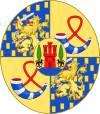 |
Queen Máxima | This oval shield combines the Dutch royal arms with the Orange family symbol. It also has a smaller shield with the arms of her father's family, Zorreguieta. |
 |
 |
Children of King Willem-Alexander (Princesses Catharina-Amalia, Alexia and Ariane) |
This shield combines the Dutch royal arms with the Orange family symbol. It also has a smaller shield with the arms of their mother's family, Zorreguieta. |
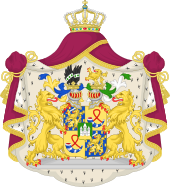 |
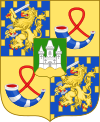 |
Children of Princess Beatrix (Prince Constantijn) |
This shield combines the Dutch royal arms with the Orange family symbol. It also has a smaller shield with the arms of their father's family, Amsberg. |
 |
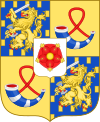 |
Princess Beatrix | This shield combines the Dutch royal arms with the Orange family symbol. It also has a smaller shield with the arms of her father's family, Lippe. |
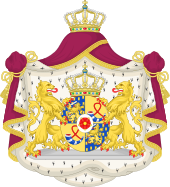 |
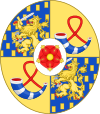 |
Children of Queen/Princess Juliana (Princesses Irene, Margriet and Christina) |
This oval shield combines the Dutch royal arms with the Orange family symbol. It also has a smaller shield with the arms of their father's family, Lippe. |
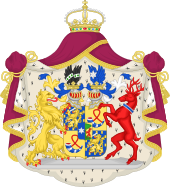 |
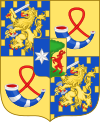 |
Children of Princess Margriet (Princes Maurits, Bernhard, Pieter-Christiaan and Floris) |
This shield combines the Dutch royal arms with the Orange family symbol. It also has a smaller shield with the arms of their father's family, Vollenhoven. |
See also
 In Spanish: Escudo de los Países Bajos para niños
In Spanish: Escudo de los Países Bajos para niños
- Coats of arms of provinces of the Netherlands
- Dutch Republic Lion


